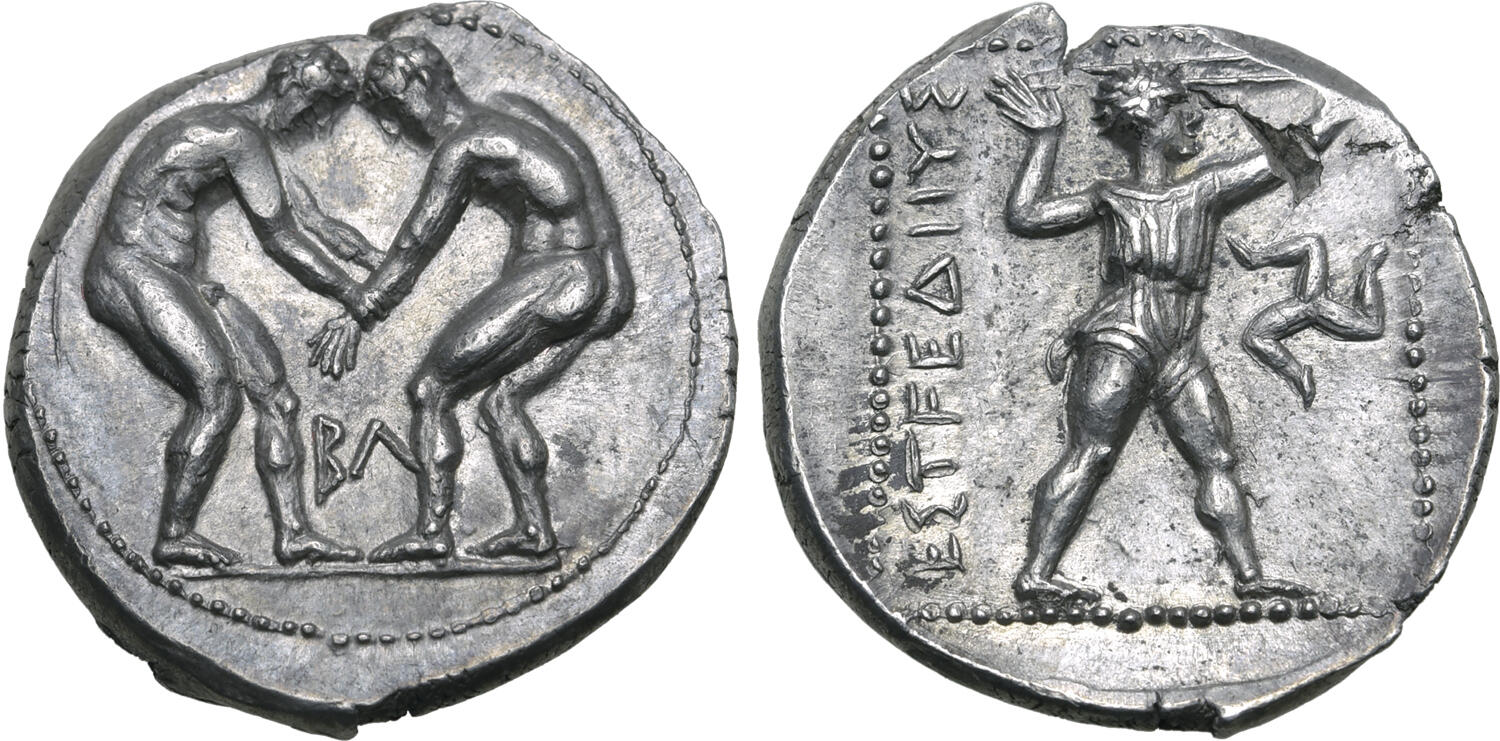Aspendus, silver, double sigloi (Varsak-Düden hoard) (380-333 BCE) Arslan - Lightfoot
From SILVER
380 BCE - 333 BCE Silver 9,455 kg
Description
| ObverseInscription or printing placed on the obverse.: | Two wrestlers grappling, BΛ between legs, all within pelleted circle |
| ReverseInscription or printing placed on the reverse.: | EΣTFEΔIIYΣ to left (Pamphylian).Slinger in throwing stance to right, triskeles to right, all within pelleted square |
Mint and issuing power
| MintIdentifies the place of manufacture or issue of a numismatic object.: | Aspendus | Ancient regionAncient region.: | Pamphylia | Modern countryModern country: Turkey | AuthorityIdentifies the issuing power. The authority can be "pretended" when the name or the portrait of X is on the coin but he/she was not the issuing power. It can also be "uncertain" when there is no mention of X on the coin but he/she was the issuing power according to the historical sources: | Persian Empire |
Chronology
| FromIdentifies the initial date in a range assigned in a numismatic context. | 380 BCE | toIdentifies the final date in a range assigned in a numismatic context.. | 333 BCE | PeriodTime period of the numismatic object.: Classical 480-323 BC |
Physical description
| MetalThe physical material (usually metal) from which an object is made.: | Silver |
Median weightMedian of the weights of numismatic objects (in grams). in grams | 10.70 | DenominationTerm indicating the value of a numismatic object. Examples: tetradrachm, chalkous, denarius.: | double siglos |
StandardStandard.: | Persian |
Image

S1901 Aspendos Arslan Lightfoot.jpg [1]
References
| Die study referencePublication of the study: | Arslan - Lightfoot 19991Arslan - Lightfoot 1999, pl. 1-9 | ||
| Coin series referenceReference to coin series study: | Sear II2Sear II, n° 5396-5398 | ||
| Coin series web referenceCoin series web references: | |||
Obverse dies distribution
| FrequencyFrequency of specimen in distribution. ᵖ | Number of obversesNumber of obverse dies. ᵖ (o) | % (o) | Number of coinsNumber of coins. (n) | % (n) | Die nameName(s) of the die(s). |
| 1 | 10 | 25 | 10 | 4.85 | BA1, BA2, FN2, FN3, ME2, ME3, PhiO1, -5, -6, -7 |
| 2 | 5 | 12.5 | 10 | 4.85 | FN(G)2, FN(G)3, FK1, PO2, -4 |
| 3 | 8 | 20 | 24 | 11.65 | AF2, LF2, NF1, NF2, FA1, PO1, SK1, -1 |
| 4 | 3 | 7.5 | 12 | 5.83 | AN2, ES1, -1 |
| 5 | 4 | 10 | 20 | 9.71 | FN(G)1, IO1, TN1, -3 |
| 7 | 1 | 2.5 | 7 | 3.4 | ME1 |
| 8 | 1 | 2.5 | 8 | 3.88 | AM1 |
| 10 | 2 | 5 | 20 | 9.71 | AN1, LF1 |
| 12 | 2 | 5 | 24 | 11.65 | ML1, PhiK1 |
| 13 | 1 | 2.5 | 13 | 6.31 | AF1 |
| 16 | 1 | 2.5 | 16 | 7.77 | KI1 |
| 20 | 1 | 2.5 | 20 | 9.71 | AK1 |
| 22 | 1 | 2.5 | 22 | 10.68 | FN1 |
| Total | 40 of 40 | 100 | 206 of 206 | 100 |
Reverse dies distribution
no distribution is available
Quantification
| Number of obversesNumber of obverse dies. ᵖ (o) | 40 | Number of singletons (o1)The number of singleton coins. ᵖ | 10 |
| Number of reverse diesNumber of reverse dies. (r) | 143 | Number of coinsNumber of coins. (n) | 206 |
| Coins per obverse dieNumber of coins per obverse die. (n/o) | 5.15 | Coins per reverse dieNumber of coins per reverse die. (n/r) | 1.44 |
| Reverse per obverse ratioRatio of obverse dies divided by reverse dies. (r/o) | 3.58 | Percentage of singletons (o1)number of coins (n) divided by the number of singletons (o1) ᵖ | 25 % |
| Original number of dies (O) (Carter 1983 formula)The estimation of the number of coins according to Carter 1983 ᵖ | 44.18 | Coins struck if 20,000 as average productivity per dieCoins made if the average productivity for obverses (according to Carter) is 20,000. ᵖ | 883,600 |
| Original number of dies (O) (Esty 2011 formula)The estimation of the number of coins according to the singleton formula in Esty 2011 ᵖ (O) | 49.64 | Survival rate if 20,000 as average productivity per dieSurvival rate if average productivity is 20,000. ᵖ | 0.00023 |
| Coverage (o = % of O) (Esty 1984 formula)Esty 1984 - coverage (% of O) ᵖ (o = % of O) | 95.15% | Die productivity if survival rate 1/2,000Average productivity if survival rate is 1/2,000. ᵖ | 9,325.49 |
| Weight of silver (in kg) if 20,000 coins per die (O = Carter formula)Carter 1983 * Median weight * 20000 (*10 if gold or electrum) ᵖ | 9,455 kg <br /> 9,455 kg | Die productivity if survival rate 1/5,000Average productivity if survival rate is 1/5,000. ᵖ | 23,313.72 |
Remarks
Most likely one single workstation Likely military Most obverse dies are identified by a set of two letters; a few ones with an additonal artist signature (G); the last ones without any letters (-). This die study is built on a single hoard and does not pretend to be complete (but see the good n/d ratio). See S 1642 (Callataÿ 2016) for a full die study of one single variety.